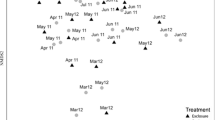Abstract
Terrestrial metamorphs of the salamander, Ambystoma jeffersonianum, were exposed to four levels of pH on artificial substrates in the laboratory. Short-term exposure (7 d) to pH levels between 3.5 and 5.0 had no effect on total body mass, Na+, K+, Ca2+, and Mg2+ concentrations. However, at 14 d in both laboratory experiments and in field microcosms, whole body water and Na+ concentrations were significantly lower at the lower pH level. Terrestrial metamorphs and adults of the Jefferson salamander preferred artificial substrates that were higher in pH. Ponds not utilized for breeding all had adjacent soil pH below 3.7. Pond water and soil pH were directly and highly correlated. Soil pH may indirectly affect breeding success of Jefferson salamanders by influencing pond pH or directly by physiologically stressing the terrestrial life stages. Laboratory data implicate direct effects on the physiology of terrestrial young of the year salamanders by induction of loss of body water and Na+. Apparently, soil pH is a critical factor not only in the selection of vernal ponds by Jefferson salamander adults for breeding, but in determining the likelihood of reproductive success as judged by recruitment into the adult population.
Similar content being viewed by others
References
Behler JL (1988) The Audubon Society field guide to North American reptiles and amphibians. Knopf, New York, 743 pp
Burton TM, Likens GE (1975) Salamander populations and biomass in the Hubbard Brook Experimental Forest, New Hampshire. Copeia 1975:541–546
Dunson WA, Packer RK, Dunson MK (1971) Ion and water balance in normal and mutant fluid imbalanced (ff) embryos of the axolotl Ambystoma mexicanum. Comp Biochem Physiol 40A:319–337
Dunson WA, Wyman RL, Corbett ES (1992) A symposium on amphibian declines and habitat acidification. J Herp 26(A):349–352
Freda J, Dunson WA (1984) Sodium balance of amphibian larvae exposed to low environmental pH. Physiol Zool 57(4):435–443
Freda J (1991) The effects of aluninum and other metals on amphibians. Environ Pollut 71(1991):305–328
Frisbie MP, Wyman RL (1991) The effects of soil pH on sodium balance in the red-backed salamander, Plethodon cinereus, and three other terrestrial salamanders. Physiol Zool 64:1050–1068
—, — (1992) The effect of environmental pH on sodium balance in the red-spotted newt, Notopthalmus viriidescens. Arch Environ Contam Toxicol 23:64–68
—, — (1992) The effect of soil chemistry on sodium balance in the red-backed salamander. A comparison of two forest types. J Herp 26(4):434–442
Hairston NG Sr (1987) Community ecology and salamander guilds. Cambridge Univ Press, Cambridge, UK, 230 pp
Krug EC, Frink CR (1983) Acid rain on acid soil: A new perspective. Science 221:520–525
MacDonald DG, Reader JP, Dalziel TRK (1989) Acid toxicity and aquatic animals. Cambridge University Press, Cambridge, UK, pp 221–242
McCoy CJ (1982) Amphibians and reptiles in Pennsylvania. Carnegie Museum of Natural History, Pittsburgh, PA, 91 pp
Mushinsky HR, Brodie ED (1975) Selection of substrate pH by salamanders. Am Midland Nat 93:440–443
Packer R, Dunson WA (1970) Effect of low environmental pH on blood pH and Na balance of brook trout. J Exp Biol 174:65–72
—, — (1972) Anoxia and sodium loss associated with the death of brook trout at low pH. Comp Biochem Physiol 41A:17–26
Rowe CL, Sadinski WJ, Dunson WA (1992) Effects of acute and chronic acidification on three larval amphibians that breed in temporary ponds. Arch Environ Contam Toxicol 23:339–350
Rowe CL, Dunson WA (1993) Relationships among abiotic parameters and breeding effort by three amphibians in temporary wetlands of central Pennsylvania. Wetlands 13(4):237–246
Sadinski WJ (1991) Effects of low pH on communities of temporary ponds in central Pennsylvania, PhD dissertation. Pennsylvania State University, University Park, 253 pp
Sadinski WJ, Dunson WA (1992) A multilevel study of effects of low pH on amphibians of temporary ponds. J Herp 26(4):413–421
Shiels R (1993) Effects of atmospheric deposition and ground water hydrology on vernal pond water chemistry, MS Thesis in Forestry. Pennsylvania State University, University Park
Warner SC, Dunson WA, Travis J (1991) Interaction of pH, density, and priority effects on the survivorship and growth of two hylid tadpoles. Oecologia 88:331–339
Wood CM (1992) Flux measurements as indices of H+ and metals effects on freshwater fish. Aquat Toxicol 22:239–264
Wyman RL (1988) Soil acidity and moisture and the distribution of amphibians in five forests of southcentral New York. Copeia 1988:394–399
Wyman RL, Hawksley-Lescault DS (1987) Soil acidity affects distribution, behavior, and physiology of the salamander Plethodon cinereus. Ecology 68(6):1819–1827
Wyman RL, Jancola J (1992) Degree and scale of terrestrial acidification and amphibian community structure. J Herp 26:392–401
Author information
Authors and Affiliations
Rights and permissions
About this article
Cite this article
Horne, M.T., Dunson, W.A. Behavioral and physiological responses of the terrestrial life stages of the Jefferson salamander, Ambystoma jeffersonianum, to low soil pH. Arch. Environ. Contam. Toxicol. 27, 232–238 (1994). https://doi.org/10.1007/BF00214267
Received:
Revised:
Issue Date:
DOI: https://doi.org/10.1007/BF00214267




